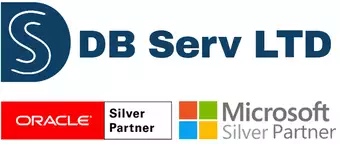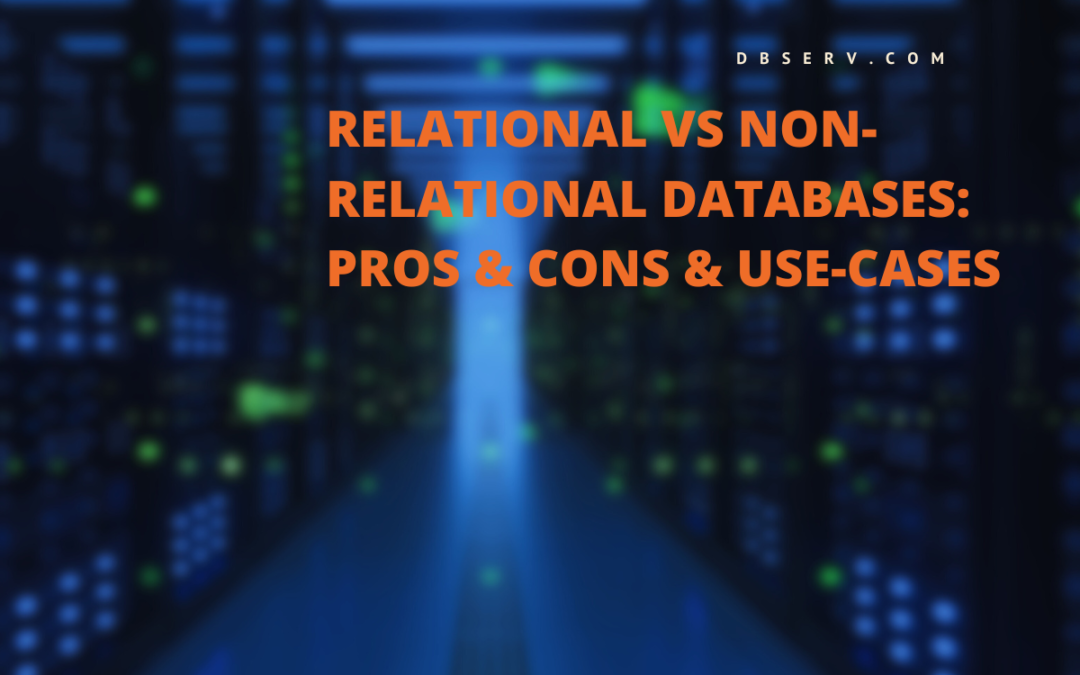Regardless of size, every enterprise needs to gather, process, analyze, and store data. This work with information promotes advancement, the achievement of business goals, and overall company stability. Therefore, tools for managing large amounts of diverse data become a crucial component of corporate software.
Two types of databases are distinguished – relational and non-relational. What are they designed for, and which one does your business need? In this article, we will thoroughly explore the topic of relational databases vs. non-relational databases and highlight the key advantages and disadvantages. We will also provide examples of when it’s better to use one type of database over the other.
What are Relational Databases?
A relational database (RDB) is designed to store data in tables with rows and columns, and a relational Database Management System (RDBMS) is used to manage them. Such databases facilitate working with structured data, i.e., well-defined data types like dates, names, and numbers. Relational databases are also known as SQL databases because specialists use the SQL query language to retrieve information from tables.
A relational database somewhat resembles Excel sheets. There are columns with headings and rows containing the information placed within them. Special identifiers, known as keys, are used in the database. These keys help establish relationships between different tables.
Keys in RDB are divided into:
⚫️ Primary keys, serving as unique identifiers for each row, thus avoiding data duplication in columns.
⚫️ Foreign keys, denoting columns that point to the value of a primary key in another table.
The process of organizing data in an SQL database is called normalization. It involves establishing relationships between tables according to rules that ensure data protection and the database’s flexibility by eliminating redundancy and conflicting dependencies. As a result, you can use information from one table in another and obtain comprehensive data throughout the database. Additionally, such relationships allow for quickly retrieving necessary information, adding, deleting, updating, editing, and preventing duplicate rows.
Among the most commonly used relational DBMSs are:
★ Oracle Database
★ MySQL
★ PostgreSQL
★ Microsoft SQL Server
★ MongoDB
Benefits of relational databases
To better understand the topic of relational vs. non-relational databases, let’s delve into the advantages provided by SQL databases:
➡️ Structure: Storing data in table format significantly simplifies management, organization, and understanding of information.
➡️ ACID Compliance: Most relational databases adhere to the ACID standard (Atomicity, Consistency, Isolation, and Durability), which ensures system stability even in cases where a single change failure disrupts the entire transaction. Consequently, the database remains in the same state as before attempting the transaction.
➡️ Data Accuracy: Keys contribute to data integrity and accuracy by preventing duplication and eliminating incorrect relationships between tables.
➡️ Ease of Use: SQL databases offer a wide range of tools and resources to facilitate and enhance work with them. The query language, which resembles English syntax, enables professionals to easily form queries and reports based on information.
➡️ Reliability and Security: Thanks to their structured nature, relational databases make creating backups for disaster recovery easy. They also provide access control management and authentication configuration to control who works with the information and when.
Disadvantages of relational databases
In addition to their advantages, RDBs also have some weaknesses. Let’s explore them to better understand the topic of a relational database vs. non-relational one:
➡️ Limited Flexibility: Databases primarily handle structured information. They also have clear schemas for working with data, leading to column and row length and format constraints. This makes processing and storing unstructured, variable, and complex data challenging.
➡️ Limited Scalability: A database operates only on a single virtual machine (VM). As data sizes increase, they will eventually surpass the VM’s capabilities. This necessitates hardware upgrades, i.e., vertical scalability, which can result in significant financial expenses.
➡️ Performance Degradation: As data arrays added to tables expand, their processing time can increase. Large volumes of information and the complexity of managing them require skilled database administrators to optimize performance and maintain efficiency.
Let’s consider the second information processing tool to get a comprehensive view of the relational vs. non-relational database comparison.
What Are Non-Relational Databases?
A non-relational database, also known as a NoSQL database, sets itself apart from traditional SQL databases by its ability to handle a wide array of information types. For instance, it works with data in JSON documents, unstructured text, graphs, and key-value pairs. These databases can utilize clusters to distribute information across multiple servers for faster processing, scalability, and system availability in the event of node failures.
Some of the most sought-after NoSQL systems in the market include:
⚫️ MongoDB
⚫️ Apache Cassandra
⚫️ Couchbase
⚫️ IBM Cloundant
⚫️ Amazon DynamoDB
In the debate of a relational vs. non-relational database, it’s important to consider a crucial fact: NoSQL databases were designed with cloud technologies in mind, providing a straightforward process of horizontal scalability, whereas SQL databases can only scale vertically.
Types of non-relational databases
Another significant distinction is that non-relational databases are categorized into several types based on how they store information:
⚫️ Document-Oriented Database: Here, data is stored as documents in formats like JSON, BSON, XML, etc. Each document has fields and values for filtering arrays of information and sending queries. These documents can be separate units and may be distributed and stored on different servers. This type of NoSQL database can thus self-heal, ensuring high availability.
⚫️ Columnar Data Stores: In these stores, data is saved in columns, tables, and rows, making them similar to relational databases. However, unlike SQL databases, formats and names of columns/rows can vary within the same table. In such storage, you can easily optimize queries requiring large sets of rows.
⚫️ Key-Value Stores: This type of database has a simple structure where information is stored in pairs of keys and values. Each pair is unique and used to identify specific data.
⚫️ Graph Databases: This type of storage presents information in graphs, consisting of sets of data nodes representing objects and edges representing the relationships between them. Graph databases are one of the most complex types since they lack a standard query language, making information movement between different database types more challenging.
Benefits of non-relational databases
To compare relational databases vs. non-relational databases, let’s explore the strengths of NoSQL databases:
➡️ High Performance: Non-relational databases offer swift system responsiveness to a query. This ensures quick processing for reading, writing, and other data operations, even under heavy loads.
➡️ Scalability: These databases excel in distributed systems where information is stored in new nodes, graphs, or documents. Their high scalability allows for effortless addition of information with minimal delays.
➡️ Diverse Data Models: NoSQL enables working with multiple data models and creating custom schemas. This makes them well-suited for projects with varying requirements, capable of handling different data structures.
➡️ Flexibility: These databases handle various types of structured and unstructured data while remaining highly flexible and capable of managing large data volumes.
➡️ Enhanced Efficiency: Non-relational databases serve as effective tools for processing diverse data types and formats, making them particularly valuable for log analysis projects and similar scenarios.
Disadvantages of non-relational databases
However, NoSQL databases also come with drawbacks that need consideration when weighing relational database vs. non-relational database options. The weaknesses of the latter tend to include:
➡️ Integration Complexity: Non-relational databases lack standardized data structure definitions and query execution procedures, unlike relational databases. This might lead to difficulties when migrating databases to different platforms or integrating them with external systems.
➡️ Management Complexity: NoSQL lacks a standardized query language for obtaining the necessary information. This leads to hiring qualified management administrators or training staff in new languages and various interfaces.
➡️ Absence or Limited ACID Compliance: Non-relational databases have limited support for transactions; some might not support them, while others partially adhere to the ACID standard. Thus, weak or absent transaction support can threaten data consistency and recovery.
When making a choice, it’s crucial to consider both database types’ pros and cons and consider the project’s type and specifics to determine the best fit.
Relational vs Non-Relational Databases: What and When to Choose?
The correct data modeling, indexing, and partitioning are essential to achieve high database performance. The “entity-relationship” model is available for managing structured information in a relational database, which cannot be implemented in a non-relational database.
However, SQL might struggle with unstructured data, whereas NoSQL, on the contrary, is designed precisely for this purpose. Based on these facts, we can outline the main business use cases for choosing between relational vs. non-relational databases.
Relational databases are suitable for:
⚫️ The banking sector, to maintain transaction integrity and reliability.
⚫️ E-commerce, where managing customer data, sales, inventory, and analyzing reports is crucial.
⚫️ Customer relationship management (CRM), where processing data and establishing connections between them are important.
⚫️ The financial sector for processing financial information and data analysis.
Non-relational databases are suitable for:
⚫️ The big data industry, where processing and storing massive amounts of real-time information is essential.
⚫️ Internet of Things (IoT) for storing and analyzing large volumes of data from various dispersed sources.
⚫️ Social media, where there’s a lot of unstructured information that requires system flexibility and rapid response.
⚫️ Creative projects that involve storing and processing various data types, including images, texts, geolocation, and more.
When choosing between relational vs. non-relational database, it’s important to consider how much flexibility, reliability, scalability, and speed of data collection, storage, and processing matter for your project.
Conclusion
In the relational DB vs. non-relational DB debate, it’s impossible to determine a winner, as each has its own range of use cases and is designed to solve different tasks. Therefore, the choice of a database always depends on the intended use, your company’s specific needs, project specifics, data types processed, your staff’s level of expertise, and other factors.
Having trouble deciding? The consultants at DB Serv are ready to assist you and help select a database that best fulfills your project’s needs.

